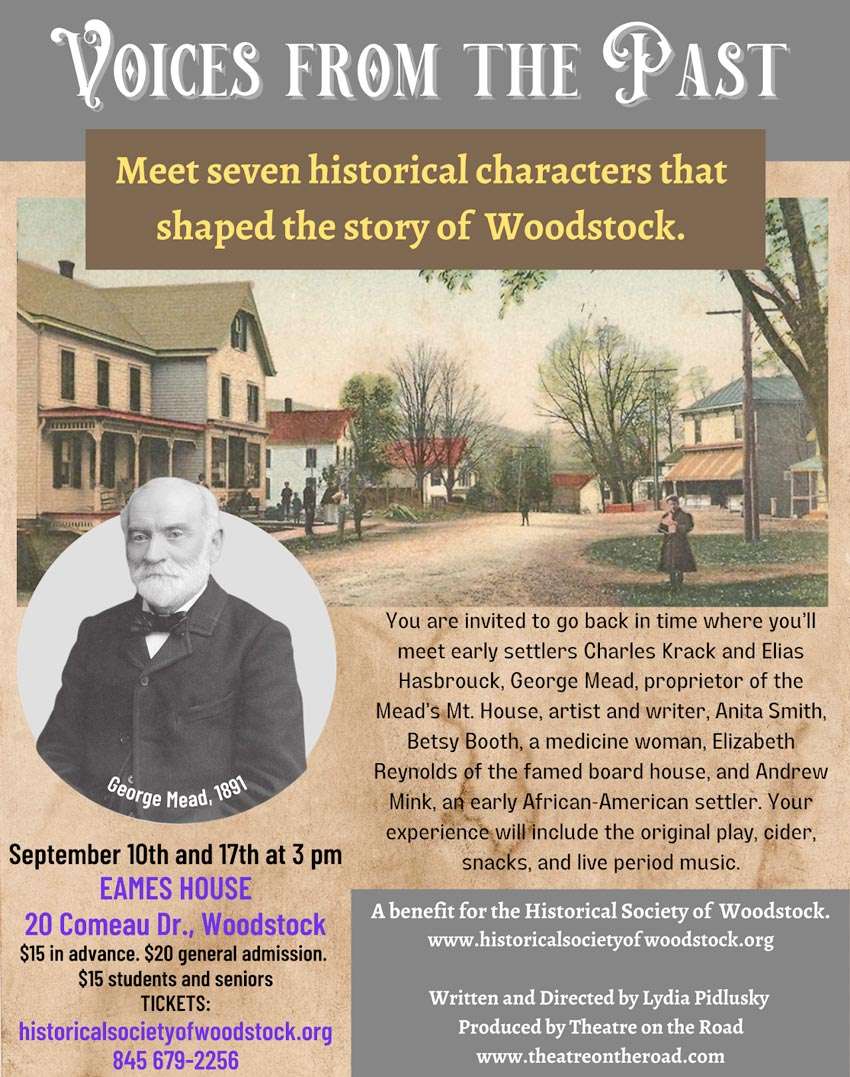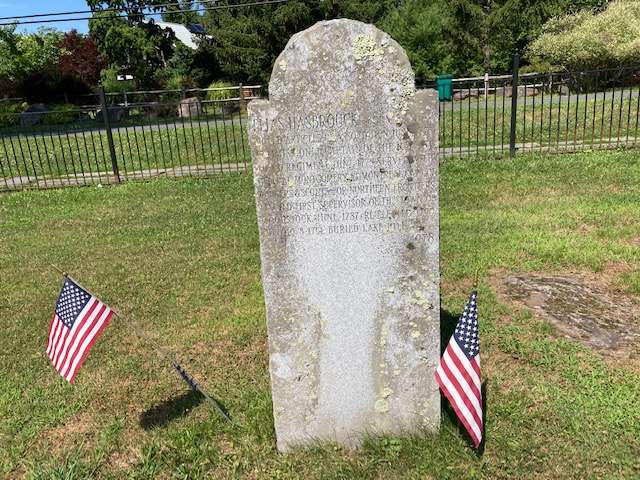Voices From The Past
Voices From The Past
September 10 and 17, at 3 pm
Eames House
20 Comeau Dr, Woodstock, NY 12498
The Historical Society of Woodstock
and Theatre on the Road
are collaborating on Voices from the Past, where you’ll meet seven historical characters that shaped the story of Woodstock.
VOICES FROM THE PAST,
an original play featuring seven historical characters that shaped Woodstock.
Theatre on the Road, a traveling company based in Rosendale, New York, will collaborate with the Historical Society of Woodstock on an original play, “Voices from the Past”, that will allow guests to meet seven characters from Woodstock’s illustrious past. Performances will be held outdoors at the Historical Society’s Eames House, 20 Comeau Drive in Woodstock on Saturday, September 10th and Saturday, September 17th at 3:00 pm. Guests are encouraged to bring folding chairs.
Both performances will be benefits for the Historical Society of Woodstock. Advance tickets are $15 per person, $20 for general admission and $15 for students and seniors. Tickets can be purchased by visiting www.historicalsocietyofwoodstock.org or by calling 845-679-2256.
Frank Marquette, the owner-operator of Theatre on the Road, is producing “Voices from the Past”. Lydia Pidlusky, a Hudson Valley based writer-singer-actor, is directing from her original script. She offers, “Through the perspectives of seven historical characters spanning two centuries, we will explore the role of women and African-Americans in
the 19th century, the explosion of tourism and the creation of the art colony, the legacy of the indigenous peoples, and Woodstock’s tradition of honoring the iconic beauty of the landscape and its independent spirit.”
Characters will share stories though monologues as well as interaction with each other. Featuring early settlers Charles Krack and Elias Hasbrouck, George Mead of Mead’s Mountain House, medicine woman Betsy Booth, Elizabeth Reynolds of the famed boarding house, Andrew Mink, an early African-American settler, and artist and writer Anita Smith. The performance will also include live period music.
The Historical Society of Woodstock was founded in 1929 by a group of artists, writers, academics, and local citizens. In addition to the exhibition space, which is located at the historic Eames House on Comeau Drive in the center of Woodstock, the Historical Society has an extensive archive consisting of paintings, prints, drawings, sculpture, textiles, photographs, books, manuscripts, correspondence, documents, film/sound recordings, and antique tools. The archive serves as a resource for a wide range of exhibitions, public programming, and research.
Theatre on the Road is the creation of actor, writer and director Frank Marquette and wife and producing partner, Kristen. Producing plays for educational, charitable and private events since 1998, they offer original scripts, professional actors, period styling and handmade costumes. Original productions include, Poe’s Last Mystery, Voices from the Past, Whiskey Women, A Taste of Shakespeare and seasonal “living history” tours in Kingston, Hurley and Rhinebeck.
Media Contact:
Frank Marquette
845-475-7973
theatreontheroad@gmail.com
Elias Hasbrouck (1741-1791)
During the Revolutionary War, Elias Hasbrouck was a merchant in Kingston, NY. When the British set fire to the stockade district in 1777, he lost his home and place of business. Hasbrouck became a captain and recruited and led a contingent of rangers in the Woodstock area. After the war, he settled near the Shandaken Mink Hollow Crossroads. His establishment included his home, a store, and an inn. The first town board meeting was held here on June 5, 1787, and shortly after that, Elias Hasbrouck became the first Supervisor of Woodstock.
Captain Charles H. Krack (1825-1893)
Charles Krack’s career began in Germany, where he served in the military. Upon coming to America in the mid-1800s, he served variously as an overseer of a South Carolina plantation, a hotel operator in New York City, and an explorer on the western frontier. Returning to New York City he became the owner of a floating bathhouse on New York City’s East River. This business was anchored near Grand Street and made Krack a fortune. He arrived in Woodstock during the 1850s and in 1870 he constructed and ran a hotel known as the Krack House to capitalize on the booming tourist industry. This structure remains in existence today and borders the northeastern part of the Village Green, and its ground floor houses the Garden Café.
George Mead (1834-1905 )
George Mead, a native of Hartford, Connecticut, silver-plated the metal parts of horse harnesses in Kingston, NY. In August 1865, he purchased the Fuller place in the Wide Clove Kill, mid-way up Overlook Mountain, and turned it into the Mead’s Mountain House. He promised, “refreshments of all kinds to render the stay of his guests pleasant and agreeable.” By 1880 he installed a 975-pound cookstove and was soon welcoming such esteemed lodgers as Sanford White, the famed architect of such wonders as the Washington Square Arch, Jervis McEntee, a Hudson River School painter, and Ralph Radcliffe Whitehead, the co-founder of the Byrdcliffe Art Colony. The Mead’s Mountain House was purchased by the KTD Monastery in 1978 and eventually torn down in 2011.
Betsy Booth
Betsy Booth married James MacDaniel in 1826 and lived on the back side of Overlook Mountain and began her herb doctoring in 1850. Her family took in summer boarders at the farm to make ends meet. Betsy was known as a vigorous walker who thought nothing of tramping to Saugerties or Kingston and returning with a bag of corn meal on her back. If it was cold, she took a hot brick for warmth. She was a pioneer feminist and was the first person in Woodstock known to have worn trousers.

Elizabeth Reynolds (1864-1931)
Elizabeth Nolan Reynolds was born in 1864 in Albany, New York. How she came to meet a boy from Shady, New York, is unknown, but all her descendants are grateful for this union. Elizabeth married William E. Reynolds and worked at Mead’s Mountain House. In 1906 they began managing the Overlook Mountain House. Later they went into business for themselves and built the Reynolds Boarding House on Mead’s Mountain Road as they saw the need for a boarding house closer to the Woodstock Village Center.
When Henry Allen Tupper hired William in 1906, he wanted to entice travelers to visit the renovated Overlook Mountain House, so he instructed William E. to write a booklet that reads:
Doubtless, many people will learn, with pleasure, that the picturesque Overlook Mountain House, located on the top of Overlook Mountain (3200 feet above the sea), is the highest point occupied by a building in the Catskill mountains, will be opened on June 15, 1906. The manager and his wife assured the public that good, wholesome fare would be served in abundance to satisfy the keen appetite created by the invigorating mountain air… for this season; the popular prices are $8.00 and $10.00 per week. Elizabeth’s culinary skills included cooking rattlesnake in a special cast iron pan she used only for that purpose!
While managing the Overlook Mountain House, the Reynolds began working on the Reynolds Boarding House. William set aside any additional lumber. Then he would load the excess lumber on the wagon and send the horses down to the base of the Overlook trail. There he would later meet his team of horses and bring the lumber the remainder of the way down Mead’s Mountain Road to the present site of the Reynolds House.
During their marriage, Elizabeth had seven children who all lived into adulthood. Elizabeth was known as a stern taskmaster, so illnesses probably were quickly terminated under her strict care. Although a simple procedure today, Elizabeth died on December 28, 1931, after complications from a hernia operation, which occurred on Christmas morning.
Elizabeth must have been quite a hearty soul to live on the mountain, run boarding houses, raise her seven children, and be a constant support to William E. himself.
~Colvin Bruce Van de Bogart
Andrew Mink
A runaway slave who settled in a Lake Hill hollow in the 1860s and gave his name to Mink Hollow Road.
Anita Smith (1893-1968)
Anita Smith was born a Quaker near Philadelphia and arrived in Woodstock in 1912 to study painting under John F. Carlson at the Art Students League. Soon her canvasses started being exhibited at the National Academy of Design, the Art Institute of Chicago, and the Woodstock Artists Association. In 1934 she moved from Lake Hill to lower Mead’s Mountain Road to a newly built bluestone cottage she built. For the next decade, she ran the Stonecrop Garden and Shop. In 1959 she independently published Woodstock History and Hearsay. This became the first official history of the town and included a wealth of information about the founding of the town and numerous stories about the early days of the art colony and its artists.
Sources
Legendary Locals of Woodstock, Richard Heppner, and Janine Fallon-Mower
Woodstock History of an American Town, Alf Evers
Woodstock History and Hearsay, Anita Smith




